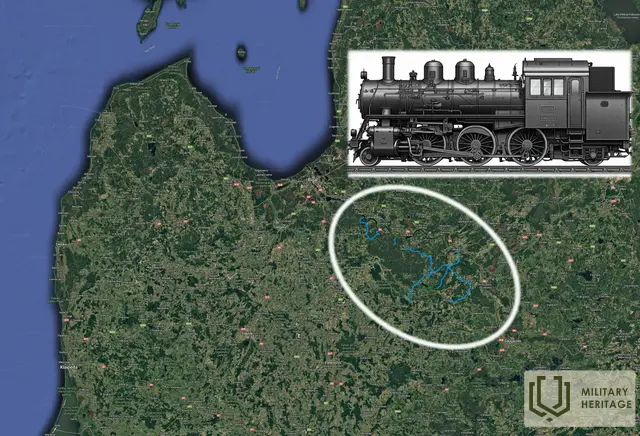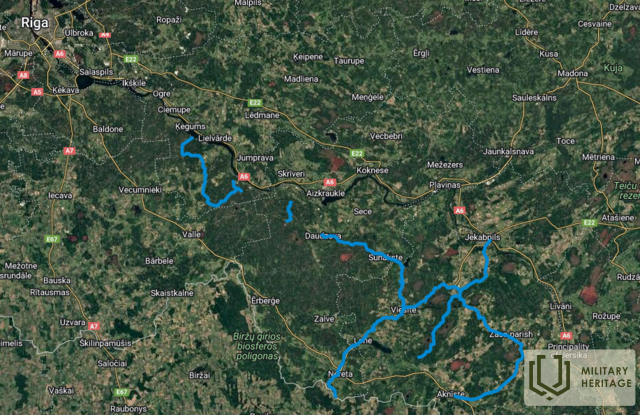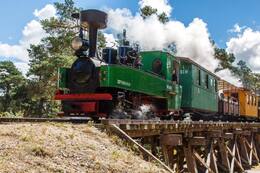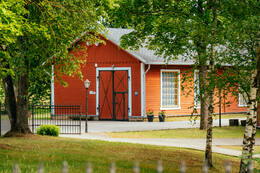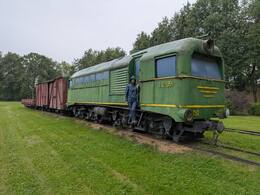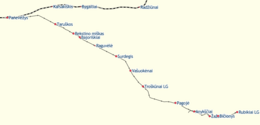600 mm siaurieji geležinkeliai Sēlijoje
Dažnai sakoma, kad karas yra visų dalykų tėvas, ir taip buvo Latvijos kaimo geležinkelių atveju. Bet kuriai armijai, nesvarbu, ar ji puola, ar ginasi, karui vykdyti reikia didelių išteklių. Kai 1915 m. Vokietijos kariuomenė įžengė į Latvijos teritoriją, susidūrė su logistiniais iššūkiais. Iki 1915 metų pabaigos frontas stabilizavosi palei Dauguvos liniją. Istoriškai Sēlijos teritorija buvo mažo gyventojų tankumo, todėl nebuvo išplitusio transporto kelių tinklo.
Pirmasis pasaulinis karas taip pat buvo laikas, kai geležinkeliai vaidino didelį vaidmenį perskirstant ir aprūpinant kariuomenę, nes kelių transportas dar nebuvo pakankamai išvystytas, o arklių traukiamos transporto priemonės nepajėgė užtikrinti pakankamo greičio ir apimties krovinių ir žmonių pervežimui. Sēliją kirto 1904 m. pradėta eksploatuoti Maskva-Ventspilis plačiojo geležinkelio linija, o trumpai - Daugpilio-Vilniaus linija. Carinė Rusija taip pat laikėsi strategijos apriboti geležinkelių tinklo plėtrą vakariniuose imperijos regionuose, siekdama sutrukdyti priešui žengti į priekį karo atveju. Atsižvelgiant į tai, didžiosiose valstybėse buvo sukurti daliniai kariniams geležinkeliams tiesti ir eksploatuoti. Karo pradžioje tokių specialiai parengtų kariškių skaičius Vokietijos kariuomenėje siekė 26 tūkst. Tarnybos metu jie buvo mokomi specialiai įrengtuose poligonuose, kuriuose per tam tikrą laiką turėjo nutiesti bėgių kelio ruožus, taip pat buvo imituojamos traukinių avarijos ir bėgių pažeidimai, kuriuos teko pataisyti savo jėgomis. Mokymams pasibaigus, per kelias dienas nežinomoje vietoje turėjo būti nutiesta visa geležinkelio linija, kurią po mokymų vėl teko išardyti. Dėl to vokiečių kariuomenė turėjo galimybę gauti gerai parengtus ir apmokytus karinių geležinkelių tiesimo ir eksploatavimo specialistus.
Karo metais okupuotose teritorijose buvo organizuojamos karinės geležinkelių direkcijos (MED). Latvijos ir Lietuvos teritorijoje tai buvo MED 8. Tokiai direkcijai pavaldi ir geležinkelių statybos, ir eksploatavimo įmonės. Direkcijai vadovavo Karinių geležinkelių viršininkas, disponavęs 1918 m. Ten jau buvo daugiau nei 441 000 žmonių, iš kurių tik 40% buvo vokiečių kariškiai.
Patys lauko geležinkeliai Vokietijoje buvo suskirstyti į dvi grupes – lauko geležinkelius (Feldbahn) ir pagalbinius geležinkelius (Forderbahn). Abiejų tarpvėžės plotis buvo vienodas – 600 mm, tačiau skyrėsi jų infrastruktūros elementai. Kaimo geležinkeliai buvo suprojektuoti kapitališkiau, jie buvo skirti dirbti su garvežiais. Kad garai nesuteiktų priešui traukinio priartėjimo, arčiau fronto buvo nutiesti atraminiai geležinkeliai, kurie buvo lengvesni, bet naudojami mažesniems dyzeliniams lokomotyvams. Taip pat buvo plačiai naudojama arklio trauka, o vagonai dažnai buvo stumiami rankomis prie pat fronto. Bėgiai buvo patys lengviausi, kuriuos leidžia reglamentai – 9,5 kg/m kaimo geležinkeliams ir 4 kg/m atraminiams geležinkeliams. Kaimo geležinkelių bėgių kelio danga buvo pramoniniu būdu gaminama 5 metrų ilgio ruožuose su geležiniais pabėgiais. Tokios sekcijos svoris siekė 220 kg, todėl ji buvo nešiojama kelių vyrų komandai. Atraminiams bėgiams buvo naudojamos 2 m ilgio atkarpos, sveriančios 40 kg. Tai reiškia, kad tokius takelius būtų galima nutiesti ir paruošti per gana trumpą laiką. Lauko geležinkelius, varomus garvežiais, ketinta tiesti 3-5 km per parą greičiu (realiam 100 km bėgių kelio ruožo nutiesimui buvo skirta savaitė). Pagalbinius geležinkelius būtų galima nutiesti greičiau – net 6-10 km per dieną. Didelę reikšmę turėjo reljefas – lauko geležinkeliai leido didelius nuolydžius ir spindulius, tačiau jei reikėjo tiesti viadukus ir tiltus, darbai užtrukdavo ilgiau.
Garvežiai svėrė 12 tonų, o dyzeliniai – tik 5 tonas. Jie buvo varomi vidaus degimo varikliu, kuris nebuvo labai galingas, tačiau turint omenyje neseniai pasirodžiusį vidaus degimo variklį, tai įrodo, kad vokiečių kariuomenė buvo techniškai labai moderni.
Gali būti, kad viena iš pagalbinių geležinkelio linijų prie pat fronto buvo nutiesta dar 1915 m. XIX a. pabaigoje, bet Sėlijoje kaip pirmoji lauko geležinkelio linija garo traukai 1916 m. Pavasarį nutiesta Skapišķi-Birži linija. Jis buvo pastatytas pagal gana aukštus standartus ir jau buvo iš anksto suplanuotas vietos eismo poreikiams. Tai patvirtina ir vėlesnis šio geležinkelio eksploatavimas Latvijoje bei Lietuvoje. Tačiau Sėlyje nutiesti geležinkeliai buvo suplanuoti grynai kariniais tikslais. Neteisinga manyti, kad vokiečiai šias linijas statė medienos eksportui, nors po 1917 m. puolimo, frontui pasislinkus kur kas toliau į rytus, jos tam buvo naudojamos, kai medienos ruošimą fronto reikmėms greičiausiai pakeitė jos eksportas į Vokietiją. 1917 m. pabaigoje siaurojo geležinkelio tinklo statusas Sēlijoje buvo pakeistas iš kaimo geležinkelių (Feldbahn) į mažuosius geležinkelius (Kleinbahn). Iš čia ir kilęs pavadinimas „mazbānītis“. Atitinkamai, Feldbahn tarnavo kariuomenės poreikiams, o Kleinbahn – civiliniam eismui. Taip pat žinoma, kad vokiečiai 1918 m. Sēlijos siaurojo geležinkelio tinklu pradėti organizuoti ir civiliniai pervežimai. Kai kurios atkarpos taip pat buvo nugriautos pažengus frontui, pavyzdžiui, Ābelių–Kaldabrūnės geležinkelis 1918 m. Spalio žemėlapiuose jo neberodoma ir nėra informacijos apie jo naudojimą. Toks buvo greitai nutiestų siaurojo armijos geležinkelių pobūdis. Tai, kad didžioji šio tinklo dalis pasibaigus Pirmajam pasauliniam karui liko Latvijos teritorijoje, yra daugiau aplinkybių sutapimas ir Vokietijos pralaimėjimas kare su vėlesniu Latvijos valstybės paskelbimu.
Iš viso Sēlijoje yra 5 kaimo geležinkelio linijos:
Skapiškis-Jēkabpils linija. Šią 110 km ilgio liniją galima laikyti pagrindiniu geležinkelių tinklu Sēlijos Karalauko regione, o Viesytės stotį – svarbiausiu geležinkelio mazgu. Linija Lietuvoje prasidėjo prie Panevėžio–Daugpilio plačiojo geležinkelio ir kirto Latviją ties Nereta;
Linija Viesīte-Daudzeva-Secē. Eismas linijoje atidarytas 1916 m. Birželio 14 d. Linija Viesytės geležinkelio mazgą sujungė su plačiosios vėžės linija Maskva-Ventspilis, jungiasi su Daudzeva ir tęsiasi iki Sece. Ši jungtis faktiškai sujungė ir Daugpilio–Panevėžio bei Masakvos–Ventspilio plačiojo geležinkelio linijas, sumažindama plačiojo geležinkelio Jelgava–Daudzeva apkrovą. Pirmoji šios linijos stotis Baznīckrogs buvo skirta tik traukinių persėdimui. Antroji stotis, Vilciniai prie Piksterės ežero, nebuvo skirta nei krovinių gabenimui, nei žmonių pervežimui – čia ji jungėsi prie lengvojo atraminio geležinkelio atšakos, kuri baigėsi netoli fronto linijos negyvenamoje vietovėje – dabartiniame pasaulio gale Rožu purs. Ši linija išsaugojo tikslią informaciją apie kitą pagalbinę geležinkelio atšaką – geležinkelių entuziastą Imantą Dreimanį 60–70 m. Devintajame dešimtmetyje jis ištyrė, kad nuo Daudzevos II stoties iki Šilniekų girininko namų ir toliau iki Pagrabkalniečio buvo nutiestas gruntinis kelias, kuriuo judėjo arklių traukiamos mašinos, o šiuo 12 km ilgio keliu vokiečiai palaikė eismą su sandėliais Jorgelani ir Silniekimber, taip pat atvežė titą. Kitas įdomus momentas – pačioje Viesytėje pastatyta 200 metrų ilgio medinė viadukas. Taupydami laiką ir medžiagas, vokiečiai nestatė pylimų, kur reikėjo, o tiesė linijas ant žemų medinių estakadų. Kadangi tuomet dar nebuvo atrastos medienos impregnavimo technologijos, tokios estakados ir tiltų konstrukcijos XX amžiaus 2 dešimtmečio pirmoje pusėje nustojo atlikti savo paskirtį ir turėjo būti pakeistos.
Linija Rokiškis-Zasas-Siliņi. Linija Lietuvoje prasidėjo ties Daugpilio–Panevėžio plačiojo geležinkelio geležinkeliu, įvažiuojant į Latvijos teritoriją ties Aknīste ir tęsiant iki Geidāni ir Zasa, kur prasidėjo atraminė geležinkelio linija fronto kryptimi. Manoma, kad šios linijos tikslas buvo pagerinti aprūpinimą Jēkabpilio ir Dvietės apylinkėse. Šioje linijoje ypač vertas dėmesio įspūdingas 15 metrų aukščio medinis tiltas per Pietų upę ties Aknīste, susidedantis iš dviejų atkarpų ir dažnai matomas vaizduose, susijusiuose su lauko vėžės geležinkeliais karo metais. Po karo jis nebebuvo naudojamas.
Eglainės apylinkių linijos. Fronto linijai ties Dviete ir Ilūkste nukrypus nuo Dauguvos ir įžengus į vidų, atsirado poreikis intensyvesniam tiekimui. Dauguva čia jau nebuvo natūrali kliūtis ir abi pusės turėjo platesnes galimybes manevruoti. Eglainės (Jelovkos) stotis buvo prie Daugpilio-Panevėžio plačiojo geležinkelio ir buvo pasirinkta kaip pagrindinis siaurojo tinklo mazgas šioje srityje. Iš šios stoties išvyko ir kaimo geležinkelio linijos, ir pagalbinės geležinkelio linijos. Čia taip pat vyko plačios perkrovimo operacijos. Prie plačiosios stoties buvo pastatyta atskira stotis siauriesiems geležinkeliams aptarnauti. Čia buvo galima saugiai kirsti plačiųjų vėžių geležinkelį, nes toliau nebuvo plačiojo geležinkelio judėjimo Daugpilio kryptimi. Iš Eglainės išvyko dvi kaimo geležinkelio linijos – Eglainė-Visagina (į pietus) ir Eglaine-Bebrene (į šiaurę). Linija nuo Eglainės iki Visagino (Čornij Brod) buvo nutiesta kruopščiai, vietoj medinių viadukų naudojant pylimus. Iš Visagino į Zarasus taip pat 1916 m. Prekyba traukiniais atnaujinta birželio 1 d. Nuolatinis stočių išdėstymas kas kelis kilometrus rodo, kad ši linija buvo intensyviai naudojama. Linija buvo svarbi ir Nepriklausomybės kovų metu, kai karinės technikos atsargos buvo tiekiamos net iš Lenkijos. Po 1920 m. Linija buvo nutraukta. Antroji linija – Eglaine-Bebrene – naudojama tik metus ilgiau. Manoma, kad uždarymo priežastis buvo daugybė laikinų medinių konstrukcijų elementų – estakadų, kurios dėl pelkėto reljefo šiose linijose buvo plačiai naudojamos ir savo laiką atlaikė. Kita priežastis gali būti maža palyginti lėto važiavimo paklausa.
Linija Obeliai-Bebrene-Dviete. Linija Lietuvoje prasidėjo nuo Daugpilio–Panevėžio plačiojo geležinkelio, ties Subate įvažiavo į Latvijos teritoriją, tęsėsi iki Kaldabrūnės, tada Bebrenės ir toliau iki fronto linijos ties Dviete. Statybos vyko 1917 m. sausio mėn. Toks laikotarpis statyboms pasirinktas, ko gero, kad būtų lengviau pritvirtinti medines estakadas įšalusioje pelkėje, o tai būtų sunkiau atšilus orams. Po karo linijos atkarpos nuo Obelių iki Kaldabrūnės ir nuo Bebrenės iki Dvietės nebenaudojamos, tačiau ruožas Kaldabrunė-Bebrene dar ilgai veikė.
Be šių pagrindinių linijų, buvo kelios atskiros trumpesnės linijos ir kelios lengvosios pagalbinės arklio traukos geležinkelio linijos, kartais einančios lygiagrečiai lauko geležinkelio linijoms, kur kursavo garo traukos lokomotyvai.
Didelė dalis siaurųjų geležinkelių ir toliau veikė po Pirmojo pasaulinio karo, visiškai uždarytos tik 1971–1972 m. metais. Tarpukariu ekonomiškai nenaudingose vietose geležinkelių tinklas buvo panaikintas, tačiau vietomis jis buvo išplėstas, nutiestos papildomos linijos. 1919. Jēkabpilyje vokiečių kariuomenė pratęsė geležinkelį 7 km, kad pasiektų Dauguvos krantus. Ši linija buvo naudojama medžiams plukdyti Dauguvos upe. Pavyzdžiui, Eglainės stotis (terminas stotis reiškia ne tik stotį, pastatą, bet ir kelią, gretimą teritoriją, pagalbinius pastatus), kuri buvo viena didžiausių fronte ir kurioje buvo numatyta ir krovinių mainai, ir riedmenų remontas, po karo nebenaudojama ir 1927 m. Geležinkelio tiesimas suteikė darbo darbuotojams, tačiau pats geležinkelis buvo svarbi medienos ruošos transporto arterija, gabenanti ir paruoštas medžiagas, ir darbininkus. 1930-aisiais 600 mm geležinkeliai Sēlijoje buvo organizuojami siekiant užtikrinti kuo platesnį pasiekiamumą vietos gyventojams, tačiau krovinių gabenimas buvo palaikomas didžiausiuose centruose ir terminalų stotyse. Eismą regione užtikrino trys linijos – Viesīte-Daudzeva, Nereta-Jēkabpils ir Aknīste-Siliņi. Linija Viesītes-Daudzevas suteikė keleiviams galimybę persėsti į plačiojo vėžės geležinkelį. Kadangi tik tam tikrose linijos atkarpose traukiniai važinėjo kasdien (Jēkabpils-Daudzeva, Viesīte-Daudzeva ir Jēkabpils-Aknīste), o kituose ruožuose tik tam tikromis savaitės dienomis, pradedant 1936 m. Latvijos geležinkeliai taip pat teikė autobusų paslaugas, kurios buvo vykdomos kasdien. Autobusų pranašumas buvo didesnis greitis, todėl į regioną atvykus autobusams, pagrindinis geležinkelio vaidmuo išliko vietinės žemės ūkio produkcijos gabenimas. Tačiau keleiviai toliau keliavo geležinkeliu. 1938 m. Žiemą dėl apsnigtų kelių laikinai sustojo net autobusų kursavimas, o geležinkelis liko vienintelė susisiekimo priemonė. Sukurtas karo poreikiams ir laikantis atitinkamų taisyklių, 600 mm geležinkelis buvo lėtas. Keleivių skundai nesiliauja, kad 60 km kelionė iš Jēkabpilio į Neretą trunka 8,5 val., o tai reiškia, kad vidutinis greitis yra 7 km/h, o dar reikia persėdimų. Iš bendro keleivių skaičiaus tik 10% galutinėse stotyse persėdo į plačiojo vėžės traukinius, o likusi dalis judėjimui regione naudojosi 600 mm geležinkeliu. Trečiojo dešimtmečio antroje pusėje gerokai sumažėjo vežamų keleivių skaičius, keleiviai mieliau važinėjosi autobusais. Po Antrojo pasaulinio karo transportas atnaujintas. Lygiagrečiai toliau vystėsi ir autobusų eismas, tačiau siaurasis geležinkelis netrūko keleivių, išlaikantis svarbų vaidmenį vietos gyventojų mobilumui. Šeštojo dešimtmečio pabaigoje geležinkelių transportas pasiekė aukščiausią tašką ir net negalėjo patenkinti visos paklausos. Skirtingai nei praėjusio amžiaus ketvirtajame dešimtmetyje, kai vietiniai gyventojai daugiausia geležinkeliu veždavo žemės ūkio produktus į turgų, o produkciją pirkdavo namo (iš esmės individuali prekyba), po II pasaulinio karo geležinkelis leido miško darbininkams patekti į savo darbo vietas, o mokinius – į mokymo įstaigas, jo svarbą lėmė planinė ekonomika ir kolūkių veiklos užtikrinimas. Grįžtant į 1930-uosius, įdomus faktas yra tai, kad prekyvietės regione dažnai būdavo organizuojamos prie geležinkelio stoties, kad būtų palengvintas prekių judėjimas. Taip pat iš kelių stočių buvo galima vežtis gyvulius iš anksto užsakius vagonus. Analizuojant krovinių gabenimą pagal grupes, XX amžiaus 2-3 dešimtmečiais didžiausią grupę sudarė mediena ir malkos, statybinės medžiagos, javai, dirbtinės trąšos, gyvuliai. Svarbų vaidmenį vaidino ir namų apyvokos prekės, kurios sudarė mažesnį procentą, tačiau vis dėlto buvo neatsiejamos nuo ekonominio ir buities gyvenimo. Tarybiniais metais stotyse buvo įkurtos medienos perkrovimo bazės, iš kurių didžiausia – prie Daudzevos ir 1958 m. Jose dirbo daugiau nei 150 darbuotojų. Nuo 1932 m. Krustpilyje pradeda veikti cukraus fabrikas, o cukrinių runkelių gabenimas tampa dar viena svarbia prekių kategorija, kurią iki uždarymo aptarnavo 600 mm geležinkelis.
Kaime veikė lokomotyvų depas, kuris buvo viena iš nedaugelio elektrifikuotų vietų. Dauguma stočių ir stotelių tarpukariu dar neturėjo elektros jungčių. Ryšio įranga taip pat buvo labai kukli; iš pradžių visam geležinkelių tinklui buvo tik trys semaforai.
Kalbant apie riedmenis, pagrindine riedėjimo traukos rūšimi tapo garvežiai su keturiomis varomųjų ratų poromis, vadinami brigadiniais lokomotyvais (Brigadelokomotive). Taip pat buvo naudojami garvežiai su trimis ar dviem varomųjų ratų poromis. Garvežiai buvo vadinamieji cisterniniai lokomotyvai, kurių cisternos (cisternos) turėjo vietos vandens rezervui. Juose taip pat buvo įrengti ežektoriai, kurie galėjo įpilti vandens iš vandens telkinių ar šulinių. Ant lengvųjų atraminių geležinkelių buvo naudojami Deutz motorvežiai su dviem ratų poromis (Forderbarhnen), o kai kur nuotraukose figūruoja ir triašiai motorvežiai Oberursel. Tokiuose lokomotyvuose buvo įrengtas vidaus degimo variklis, o kaip kuras buvo naudojamas žibalas. Atsižvelgdama į jų vertę, besitraukianti vokiečių kariuomenė visus motorinius lokomotyvus pašalino iš Latvijos teritorijos. Labiausiai paplitę vagonai buvo brigadiniai vagonai (Brigadenwagen), kurių keliamoji galia 5 tonos. Tai buvo atviro tipo keturių ašių gondolos su dviem dviašiais vežimėliais su rankiniais stabdžiais. Vagonų naudojimas buvo universalus – jais buvo vežami žmonės, ginklai, kroviniai, amunicija. Kartais medienai vežti buvo naudojami tik du vežimai, kurių kiekviename buvo po medienos krovinį. Šis sprendimas buvo laikomas pakankamai saugiu nurodytomis eksploatavimo sąlygomis. Garvežiai buvo gaminami nuo 1905 m. iki 1919 m. Vokietijos gamyklose Henschel, Borsig, Jung, Krauss, Orenstein & Koppel ir kt. Yra žinoma, kad po I pasaulinio karo Latvija toliau eksploatavo 70 tokių lokomotyvų, įskaitant kitus regionus. Savo ruožtu vagonus 1894–1917 metais gamino įvairios įmonės. Po karo nemaža dalis jų iš gondolų buvo perdaryta į uždarojo tipo vagonus, skirtus keleiviams ir kroviniams vežti. Vokiečių kariuomenės vagonai keleiviams vežti iki 1962 m., kroviniams vežti iki 1972 m. Arklio traukiamuose ruožuose buvo naudojami lengvesni 2,5 tonos keturių ašių vagonai, taip pat įvairūs vagonai, vadinami artilerijos tiekimo geležinkelio vagonais (Artielerie-Folderbahnwagen). Taip pat buvo naudojami nesudėtingi sukonstruoti autobusai.
Vikšrų komplektai buvo gaminami pagal tam tikrą standartą daugiausia Krupp gamyklose Vokietijoje. Trasos plotis buvo 70 mm. Bėgių ruožai buvo gaminami tiek tiesūs, tiek 30 m ir 60 m spinduliais. Bėgiai ir pabėgiai tarnavo ilgai – kai kurie kaimo geležinkeliai per visą savo veiklą naudojo vokiečių kariuomenės paliktą bėgių medžiagą. 1946 m. Latvijos geležinkelių kelių tarnybos ataskaitoje pažymima, kad originalūs bėgiai ant geležinių pabėgių vis dar naudojami 93,9 % visų eksploatuojamų 600 mm geležinkelių, o Viesytės geležinkelių tinkle šis skaičius siekia 99 %.
Uždarius siauruosius geležinkelius, beveik visos metalinės lokomotyvų ir vagonų dalys buvo išardytos, bėgiai išmontuoti. Atskiri lokomotyvai ir vagonai atsidūrė muziejuose. Paskutinis „Mazbānīši“ nustojo veikti 1973 m., praėjus keleriems metams po oficialaus veiklos nutraukimo. Takeliui išardyti panaudotos labai paprastos konstrukcijos – tiltas pats išardė.
Vienas iš tvirtų siaurojo geležinkelio šaknų regiono kultūroje ir socialiniuose bei ekonominiuose procesuose įrodymų – Geležinkelininkų diena, švenčiama rugpjūčio pradžioje Viesytės muziejuje „Sėlija“, kur žmonės renkasi gėlėmis išpuoštame lokomotyvų sandėlyje, nors traukiniai čia nestoja jau daugiau nei 50 metų.
Šiandien siaurųjų geležinkelių liudijimai regione neišmanantiems gali būti akivaizdūs, tačiau jų gausu ir vis dar galima rasti. Vietomis išlikę linijų pylimai, tranšėjų, kur jos kirto žemesnius plotus. Nuo Eglainės stoties Ilūkstės kryptimi yra net išlikusi geležinkelio pylimas, kuris yra dviejų arklių pločio ir kur vežimus traukė arkliai. Dalis geležinkelio linijos Pilskalnės Siguldoje paversta pėsčiųjų takais. Išliko stočių pastatai, kai kurie paversti gyvenamaisiais pastatais, kai kurie apleisti, o dalis – kaip sandėliai. Stočių pavadinimai vis dar matomi ant kai kurių stočių ir stotelių pastatų. Geriausiai iki šių dienų išlikęs Varnavos stoties kompleksas. Sēlijos muziejus įsikūręs Viesytės geležinkelio mazgoje – jam priklauso 1927 m. 1934 m. pastatytas mūrinis lokomotyvų depas ir medinių vežimų dirbtuvės. Taip pat čia eksponuojamas konservuotas garvežys Ml-635, uždaras prekinis vagonas ir platforma, taip pat motorizuotas troleibusas su troleibusu ir tarnybiniu vagonu. „Mazbanītis“ veikia Ventspilio pajūrio muziejuje po atviru dangumi, kur iš pirminės trasos atkarpų buvo sukurtos dvi veikiančios 1,4 km ir 3 km ilgio linijos.
600mm geležinkelis Sēlijoje I pasaulinio karo metais, I.Freiberga, T.Altbergs, K.Dambītis, A.Markots, Draugija „Sēlijas kultūrs projekti“, 2022;
Military Railways in Latvia 1915-1920, T.Altbergs, K.Dambītis, Ē.Jēkabsons, B.Lielkāja, Society „Sēlijas kultūras projekti“, 2024;
Kaimo geležinkeliai, T.Altbergs, A.Biedriņš, D.Punculs, A.Tukišs, Ventspilio muziejus, 2019 m.
Susijusi laiko juosta
Susijusios temos
Susijusios vietos
Siaurojo geležinkelio traukinukas „Mazbānītis“ Ventspilio Pajūrio muziejuje po atviru dangumi
Ventspilio Pajūrio muziejuje po atviru dangumi galite pasivažinėti dviem siaurojo geležinkelio linijomis su traukinuku „Mazbānītis“. Žiedinė linija yra 1,4 km, o kalnų linija – 3 km. „Mazbānītis“ – tai lokomotyvas, kuris 1916–1963 m. 600 mm siaurojo geležinkelio bėgiais vežė keleivius ir krovinius. Tai Pirmojo pasaulinio karo karinės istorijos palikimas, kuris kadaise atliko svarbų vaidmenį šiaurinės Kuržemės kultūriniame ir ekonominiame vystymesi, jungdamas gyvenvietes ir suteikdamas naujų darbo vietų.
Didelio 600 mm siaurojo geležinkelio tinklo statyba daugiausia siejama su Pirmuoju pasauliniu karu, kai 1916 m. Vokietijos armija okupuotoje Latvijos teritorijoje pradėjo kelių vadinamųjų karinių lauko geležinkelių (vok. Heeresfeldbahn) statybą. Šie geležinkeliai galėjo būti greitai nutiesti, išardyti ir perkelti į kitą fronto liniją. Latvijos siaurojo geležinkelio tinklas buvo naudojamas ir Antrojo pasaulinio karo metu. Beveik 60 metų siaurasis geležinkelis buvo vienintelė saugi priemonė keleiviams, įvairiems žemės ūkio produktams ir medienai gabenti į miestus tiek žiemą, tiek vasarą.
Viesytės muziejus „Sėlija“ (Sēlija)
Viesytės muziejų sudaro keli skyriai: Sėlijos namai, kuriuose įrengta Sėlijos kultūros istorijos ekspozicija, Turizmo informa cijos punktas, veikiantis buvusiame geležinkelio kontoros pastate, buvusi Viesytės depo lokomotyvų remonto dirb tuvė, Amatų centras ir Sėlijos siaurojo geležinkelio istorijos ekspozicija, įrengta buvusioje geležinkelio vagonų remonto dirbtuvėje. Žinomiausia Viesytės muziejaus dalis – Mažo jo Traukinuko parkas, įkurtas buvusio Viesytės geležinkelio depo teritorijoje.
Siaurąjį geležinkelį, iš pradžių skirtą kariniams kroviniams vežti, 1915–1916 m. nutiesė vokiečių kariuomenė, tačiau po Pirmojo pasaulinio karo jis buvo pritaikytas keleivių per vežimams. Muziejuje galima pamatyti 1918 m. bendrovės „Schwarzkopff“ pagamintą garvežį, 1916 m. pagamintą tarnybinį vagoną, krovininį vagoną, medienos transporta vimo platformą, vagonėlį, dreziną ir susipažinti su Sėlijos siau rojo geležinkelio istorija. Muziejui taip pat priklauso septyni istoriniai stoties pastatai. Mažojo Traukinuko parke laukiami lankytojai su vaikais. Netoli nuo minėto parko, istorinėje Viesytės stoties aikštėje yra išlikusi vienintelė Latvijoje siaurojo geležinkelio atkarpa su senoviniu vandens siurbliu. Prie stoties aikštės stovi keli istori niai pastatai: geležinkelio krovinių sandėlis, kultūros namai, keleivių stoties pastatas ir ambulatorija
Vecumnieki Railway Station
Vecumnieki railway station is located south of the village of Vecumnieki.
Vecumnieki railway station was built in 1904 as a station on the Ventspils-Moscow railway line. Initially, it was called “Neugut” (during the German occupation in 1916/1917, it was called “Neugut Kurland”). It gained greater importance during the First World War, when a European-wide railway branch was built from it. In 1916, when the German army's front line had strengthened and stabilized along the left bank of the Daugava, on March 15, a decision was made to build a 25 km railway line with a track gauge of 1435 mm from Vecumnieki to Baldone (station: Mercendarbe - Merzendorf) for the needs of supplying the front. On March 30, about 5,000 workers began work, and by May 1, the line had been built to Skarbe station, and by May 6, to Mercendarbe. The sequence of stations from south to north was as follows: Neugut Kurland, Nougut Nord, Birsemnek, Gedeng, Skarbe, Merzendorf. At the largest of the stations, Skarbe, cargo was transshipped, from where it was transported to the front by horse-drawn transport. This railway existed for only a few years, as late as 1921, logs and firewood were transported along the railway line, until it was demolished in 1925. The location of the railway line is very different in different sections - in places it is crossed by roads of various importance, in places, as the embankment is clearly visible, it crosses forest massifs. There are places that are difficult to pass during the vegetation period.
At the former Gediņi station ("Bahnhoff Gedeng"), a narrow-gauge railway branched off in a northeasterly direction, the tracks of which continued towards the Daugava. At the Sila house it crossed Silupi (Kausupi) (former station "Bhf. Sille"), but at the Podnieki house it branched off. The first branch went to the right to Berkavas, and the second to the left to Vilki mountains and then returned to the broad-gauge (1435 mm) railway at the Skarbe station.
In September 1917, the Germans built another narrow-gauge railway line (gauge of 600 mm) from Mercendarbe and Skarbe to the Daugava, where they built a pontoon bridge and opened traffic all the way to Ikšķile on October 1. The flood of December 4 washed away the aforementioned bridge.
Since 1919, the station has been called Vecmuiža. In 1926, a stone building (architect J. Neijs) was built on the site of the wooden station building destroyed in the war. In 1940, the station was renamed Vecumnieki. In 2000, passenger train traffic was closed on the Jelgava—Krustpils line; currently, this line is used only for freight train traffic.
Šaursliežu dzelzceļš Biržos
20. gadsimta šaursliežu dzelzceļa komplekss ar nozīmīgu vēsturisko, arhitektūras un ainavisko vērtību.
"Siaurukas" ir 750 mm sliežu dzelzceļš, garākais Eiropā un viens no unikālākajiem Lietuvas mantojuma objektiem, tāpēc saglabājušies šaursliežu dzelzceļa posmi ir aizsargāti kā kultūras vērtība. Lietuvā ir saglabājušies 158,8 km 750 mm (2 pēdas 5 1/2 collas ) šaursliežu dzelzceļa līniju, lai gan regulāri tiek izmantoti tikai 68,4 km (apkalpojot piecas stacijas), kuros darbojas 12 lokomotīves. Tās ir iekļautas Lietuvas Nekustamā kultūras mantojuma vietu reģistrā.
Šaursliežu dzelzceļa līnija sasniedza Biržus 1921.–1922. gadā, kad tika pagarināts dzelzceļa posms Birži–Gubernija. Šis bija pirmais šaursliežu dzelzceļa posms, kas tika uzbūvēts par Lietuvas valsts pašas līdzekļiem.
Neatkarīgās Lietuvas gadā tika uzbūvēts 467 km šaursliežu dzelzceļa. Pa to tika pārvadāti meža materiāli eksportam, kvarca smiltis, mājlopi, lini, bietes, pārtikas krājumi. Pieaugušie devās uz darbu ar vilcienu, bet bērni - uz skolu. Brīvdienās vilciens bija pilns ar ogotājiem un sēņotājiem, bet ziemā - slēpotājiem. Līdz Gubernijas līnijas galapunktam Šauļu pilsētā vilciens piestāja 16 dzelzceļa stacijās.
1922. gadā par vienu nobraukto kilometru 1. klases vagonā pasažierim bija jāmaksā 7,20 Lietuvas auksinas (vācu ostmarkas), bet par 3. klases vagonu - 1,80 Lietuvas auksinas.
Otrā pasaules kara laikā šaursliežu dzelzceļš tika militarizēts. To izmantoja arī "valsts ienaidnieku" - cilvēku, kurus padomju vara uzskatīja par nelojāliem (arī bez īpaša iemesla), - nogādāšanai vienkāršos lopu vagonos piespiedu izsūtījumā uz Sibīriju. Pēc kara šaursliežu dzelzceļa atjaunošanas un attīstības perspektīvas kļuva ļoti neskaidras. Lietuvas dzelzceļa nākotni noteica padomju ekonomikas un politikas mērķi.
No 1945. līdz 1980. gadam tika slēgti vairāk nekā 400 km no 20 šaursliežu dzelzceļa posmiem. Visilgākie palika Biržu - Joniškeļu un Joniškeļu - Paņevežas posmi, kuros bija nedaudz lielāka kravu apgrozība. Uz Biržiem ieradās 3 vilcieni: 2 kravas un 1 pasažieru vilciens. Līdz ar autotransporta paplašinšanos un attīstību šaursliežu dzelzceļš kļuva ekonomiski nestabils. 1988. gadā pasažieru pārvadājumi tika pārtraukti. 1996. gadā, Neatkarīgās Lietuvas Republikas laikā, šaursliežu dzelzceļa līnija uz Biržiem tika pilnībā slēgta.
Mūsdienās šaursliežu dzelzceļa kompleksu veido depo un stacijas ēkas, ūdensapgādes tornis un vecais dzelzceļa posms. Vēlāk, kā apliecinājums tā krāšņajiem laikiem, apskatei tika atvesta nesen pārkrāsota lokomotīve.
Aukštaitijas šarusliežu dzelzceļš
Aukštaitijas šaursliežu dzelzceļš (lietuviešu: Aukštaitijos siaurasis geležinkelis) ir 68,4 kilometru (42,5 jūdžu) garš tūristu dzelzceļš Lietuvā, kas kursē no Panevēžas līdz Rubikiem, ar 750 mm (2 pēdas 5+1⁄2 collas) sliežu platumu.
Šaursliežu dzelzceļš tika būvēts no 1891. gada ar sliežu platumu 750 mm (2 pēdas 5+1⁄2 collas). Pirmā posma būvniecība tika pabeigta 1895. gada 11. novembrī no Švenčionēļiem līdz Pastoviem, un 1898. gadā tas tika pagarināts līdz Panevēžai. Regulāra pasažieru un kravu satiksme sākās 1899. gada rudenī. Sākotnēji bija 2 depo, 14 stacijas, 15 lokomotīves, 58 dažādu tipu pasažieru vagoni, 6 pasta vagoni, kā arī 112 slēgtie un 154 atklātie kravas vagoni. 1903. gadā tika pārvadāti aptuveni 65 000 tonnu kravu un 40 632 pasažieri.
Panevēža kļuva par reģionālo centru Lietuvas neatkarības laikā (1920–1938), un tāpēc tika pārvadāts daudz izejvielu, piemēram, ogles, nafta, smiltis, sāls un mēslojums, kā arī lauksaimniecības produkcija, piemēram, lins, speķis, cukurs, graudi, milti un kokmateriāli.
Pirmā pasaules kara laikā vācu armija 1916. gadā izbūvēja divus lauka dzelzceļu līniju pagarinājumus ar 600 mm (1 pēda 11+5⁄8 collas) sliežu platumu — no Gubernijas līdz Pasvalijai un no Jonišķiem līdz Žeimeļiem. Dzelzceļš bija funkcionāli nozīmīgs starp Pirmo un Otro pasaules karu un veicināja reģiona saimniecisko attīstību. Pēc Otrā pasaules kara to pārvaldīja valsts uzņēmums „Lietuvos Geležinkeliai“.
Satiksme sāka samazināties 20. gadsimta otrajā pusē. 1996. gadā dzelzceļa līnijā uz ziemeļiem no Panevēžas tika pārtraukti pārvadājumi. Tajā pašā gadā šaursliežu dzelzceļš tika iekļauts Lietuvas Republikas nekustamo kultūras vērtību sarakstā un ieguva kultūras mantojuma objekta statusu. Pēc tam sāka kursēt tūristu vilcieni. Kravu pārvadājumi tika pakāpeniski pārtraukti 1999. gadā. 1999. gada 1. novembrī valsts dzelzceļa uzņēmumā „Lietuvos Geležinkeliai“ tika izveidota jauna Šaursliežu dzelzceļu nodaļa. Tomēr 2001. gadā pasažieru satiksme uz laiku tika pārtraukta. Kopš 2006. gada tūristu vilcienus sāka vilkt ТУ2 dīzeļlokomotīves, un tie guva labu atsaucību ar augošu pasažieru skaitu.




